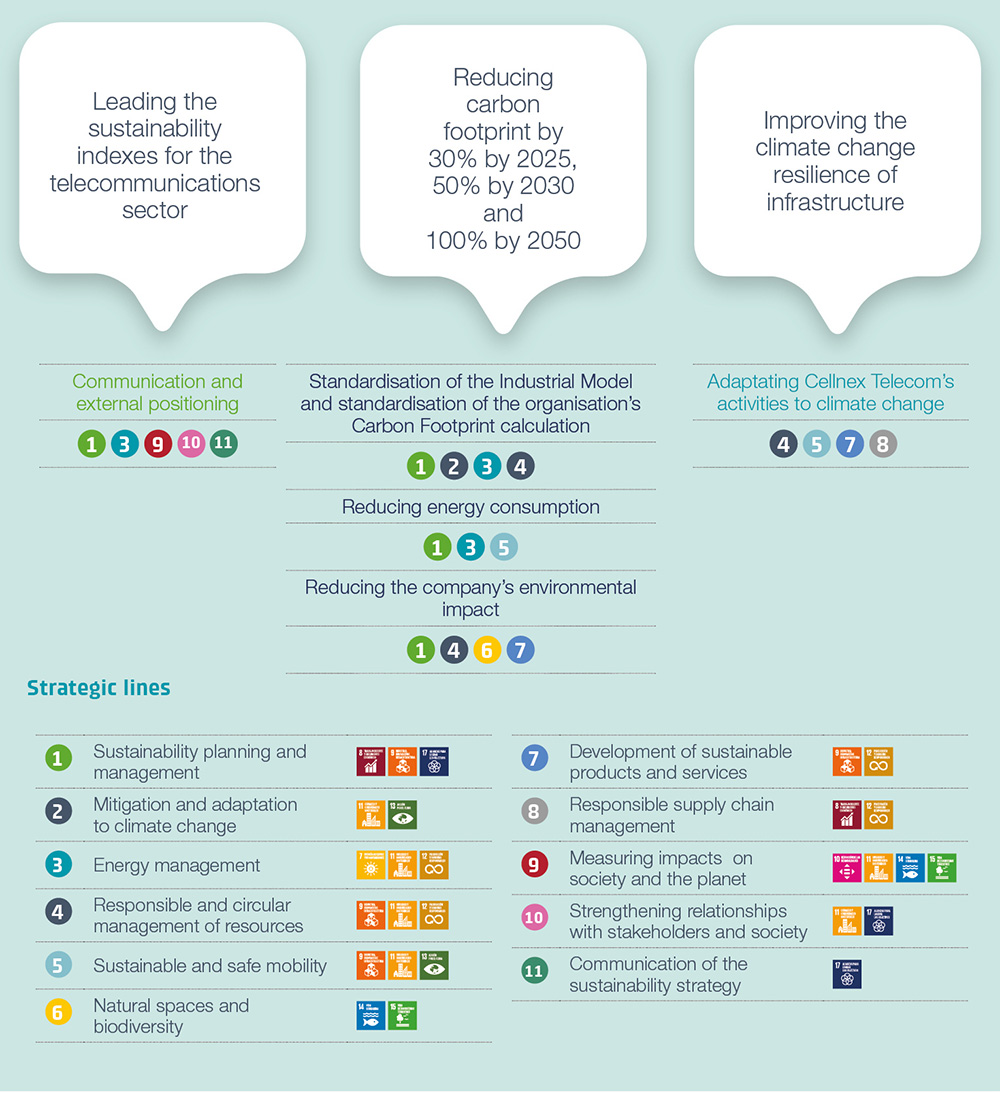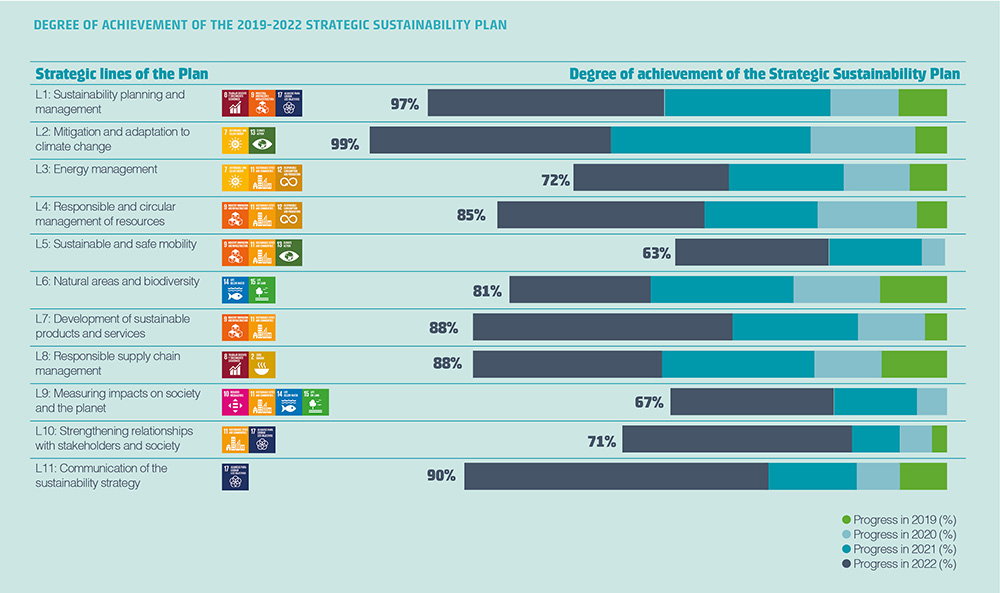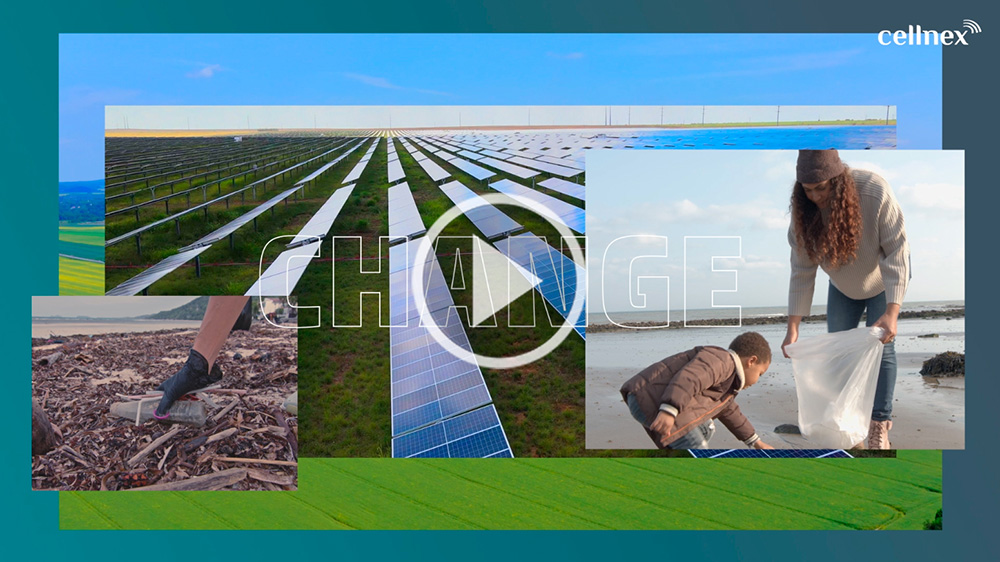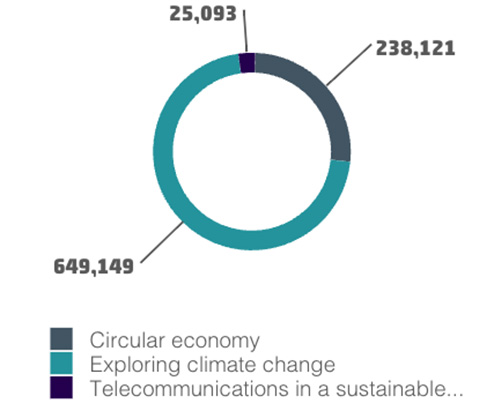One of the main goals of the Cellnex ESG Master Plan is to continue growing with a long-term sustainable environmental approach and as part of Cellnex's commitment to the environment and combating climate change, the Company has adapted its business model to incorporate the measurement, reduction and mitigation of impacts caused by its activity that may have repercussions on the environment and the biodiversity of the areas where Cellnex operates.
In this regard, in 2021 Cellnex’s Board of Directors adopted the Environment and Climate Change Policy which integrates all the principles that promote sustainable development. Moreover, to raise the company's level of responsibility, the Policy includes binding principles and commitments in each of the projects, business operations and activities undertaken by all business units. In turn, these principles and commitments are grouped in five strategic lines, aligned with the Sustainable Development Goals (SDGs).
The 2019-2023 Strategic Sustainability Plan defines the actions Cellnex will take to achieve the objectives set out in the Environment and Climate Change Policy. The Plan raises Cellnex's level of responsibility towards the environment and combating climate change and comprises 11 strategic lines designed to achieve three global objectives. In addition, the Plan is closely linked to Cellnex's global ESG strategy and the 2021-2025 ESG Master Plan.
To evaluate the performance of the Strategic Sustainability Plan and determine the actions required to achieve the targets set for 2023, Cellnex monitors the annual degree of achievement of each of the lines of action. For 2022, Cellnex established a series of targets grouped into actions to continue making progress in the Strategic Sustainability Plan. In this regard, the achievement rate for the actions outlined in 2022 was 97%. Cumulative achievement of the Strategic Sustainability Plan stood at 82% in 2022.
Further information about each of the sections of the environmental chapter can be found in the 2022 Environment and Climate Change Report, available on the corporate website.


Completion of the 2019-2023 Strategic Sustainability Plan has been brought forward to 2022 as part of a process to update the Strategy and rename it the 2023-2025 Environment and Climate Change Strategy. For the update, current and future regulations on environmental sustainability issues were taken into account (such as the Corporate Sustainability Reporting Directive, European sustainability reporting standards and the EU Taxonomy), along with Cellnex's internal commitments (such as the Science-based Targets, Net-zero Strategy, Cellnex Energy Policy and Energy Transition Plan).
As a result of this work, the new plan has 40 actions grouped into eight lines of action. The linkages between the Strategic Sustainability Plan and the Environment and Climate Change Strategy are as follows:
|
Commitment in 2019 |
Commitment in 2023 |
|
Leading the sustainability indexes for the telecommunications sector |
Achieving excellence and being an industry benchmark in integrated environmental management within the telecommunications sector, establishing a solid commitment throughout our value chain |
|
Reducing our carbon footprint 30% by 2025, 50% by 2030 and 100% by 2050 |
Being a leading group in the fight against climate change by achieving carbon neutrality, improving the resilience of our infrastructure and promoting a circular economy in line with our activity |
|
Improving the climate change resilience of infrastructure |
Improving our environmental impact, integrating our infrastructure into the surrounding environment and establishing collaborative partnerships with stakeholders |
|
Strategic Lines in 2019 |
Strategic Lines in 2023 |
|
Sustainability planning and management |
1. Integrated environmental management |
|
Mitigation and adaptation to climate change |
2. Climate change |
|
Energy management |
3. Energy management |
|
Responsible and circular management of resources |
4. Circular economy |
|
5. Water management |
|
|
Sustainability and safe mobility |
(*) |
|
Natural spaces and biodiversity |
6. Biodiversity and land use |
|
Development of sustainable products and services |
(*) |
|
Responsible supply chain management |
(*) |
|
Measuring the impacts on society and the planet |
7. Environmental impacts of infrastructures |
|
Strengthening relationships with stakeholders and society |
8. Training, awareness and collaboration with the Community |
|
Communication of the sustainability strategy |
(*) |
(*) Strategic Lines 5, 7, 8 and 11 in the 2019 Plan have been integrated into other more general Strategic Lines in the 2023 Plan.
In addition tp the strategic plans, Cellnex has an Environmental Management System (EMS) in place to achieve responsible management to ensure that policies and procedures advocating sustainability are designed and implemented. Seven business units are already integrated into the Global EMS (France, Portugal, Ireland, Switzerland, the Netherlands, Poland and the United Kingdom), and Spain and Italy now have the ISO 14001 certification and are due to be integrated into the Global Integrated Management System in 2023.

To increase transparency in environmental performance, in 2022 Cellnex published the second annual Environment and Climate Change report which contains information and follow-up on initiatives and projects undertaken during 2021. In 2022 a video was also published on internal and external channels to increase awareness and dissemination of Cellnex's environmental strategy and climate objectives.
With regard to environmental and climate change education and awareness, in 2022 Cellnex continued with its collaboration project with the education provider Ambientech to introduce sustainability and telecommunications training content in lower and higher secondary schools. The educational pathway is publicly available free of charge and covers three subjects: telecommunications in a sustainable world, exploring climate change and the circular economy. In addition, there was an inter-school competition focusing on solutions for environmental problems and a series of debates on human and environmental health. The three modules have received a total of 912,363 views.
Ambientech learning pathways. Number of visits during 2021-2022

In addition, in 2022 the initiative developed by Cellnex at Ambientech was selected to form part of Forética's Roadmap towards a Future of Work focused on green jobs and a just transition (Jobs 2030). This initiative is designed to support and raise the profile of business activity focusing on a more sustainable and ethical Future of Work, examining the most significant factors to achieve a fairer transition in adaptation and development in digitalisation.
During the 2021-2022 academic year, Cellnex also participated in the second edition of a collaborative project called "The Smart Green Planet", which aims to make the planet more sustainable. In this collaborative project, various secondary schools in Spain and Latin America submit projects with solutions for multiple environmental issues such as food, awareness, consumption, biodiversity, social inclusion and waste. A total of 473 students took part and, under the umbrella of the Smart Green Planet collaborative project, they consulted the aforementioned circular economy and climate emergency pathways, among others, as well as some projects on waste management and climate change.
A third project involving Cellnex during the 2021-2022 academic year was a school event called "Series of discussions: One World One Health", organised by Ambientech to raise young people's awareness of the interconnectedness between human health, animal health and environmental health. The event was held online from 23 to 26 May 2022 with multiple videoconferences on the Zoom and Menti platforms and an app to accompany the discussion with questionnaires and quizzes to add spark to the proceedings. The event centred on two discussions, one on how infectious diseases caused by antibiotic-resistant bacteria affect public health and another on how the environmental impact on the planet influences the overall health of people, animals and plants. Over 400 students from nine schools in Spain and Latin America took part in the project.
Uso de cookies
Utilizamos cookies propias y de terceros para analizar nuestros servicios y mostrarle publicidad relacionada con sus preferencias. Pulsando “Configurar” puede seleccionar las cookies que se instalarán en su dispositivo. Pulsando “Aceptar” consiente su instalación y el uso de todas las cookies que utilizamos. Puede obtener más información aquí.
ACEPTAR COOKIES Configuración de cookies